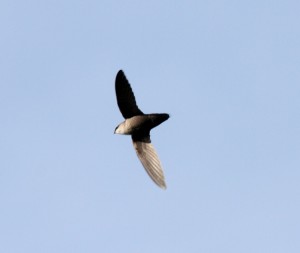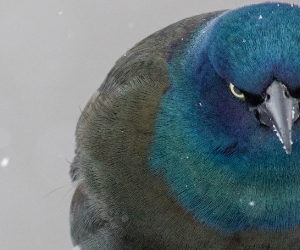Species Spotlight: Chimney Swift
Get to know some of the species at risk in the Lac Deschênes IBA with the Species Spotlight, aka “Sp-Spot”. Today meet the: Chimney Swift

Chimney Swift in flight
Dominic Sherony
Scientific Name: Chaetura pelagica
SARA Status: Threatened; Ontario: Threatened; Quebec: Special Concern
Taxonomic group: Birds
Size: 12-14 cm size, with a wingspan of 27-30 cm. and weighing 17-30g
Chimney Swifts fly constantly and are almost never seen perched. They are easily identified in flight by their silhouette characterised by long, narrow, curved wings. The Chimney Swift’s song is easy to notice once you’ve heard it. You’ll be surprised how often you can hear the high-pitched twittery cacophony once you start listening for it.
When Chimney Swifts do stop flying they cling to the walls of rough, vertical surfaces with their long claws. Before European settlement these birds would have roosted in caves and hollow tress. The construction of stone and brick chimneys provided the perfect alternative at the same time as much of their natural roosts were removed by forestry. These birds thrived with the early construction of cities and became common.
Today their numbers are suffering from changes in chimney design. Covered or narrow flutes make the chimney inaccessible, and updating chimneys with a smooth interior mean that there is nowhere for these birds to cling onto. At the same time, fewer buildings are being built with chimneys as a chimney’s function has become obsolete with advances in heating technology.
One of the most fascinating behaviors of the Chimney Swift is how large flocks of them simultaneously fly head first into their chimney roost at dusk without injury. Watching a group funnel into a chimney it is easy to believe that Chimney Swifts nest in colonies. While hundreds of non-breeding swifts may share a roost during the spring, only one pair nests in a chimney at a time. So every chimney is crucial.
Where Else Can You See This Species?
Chimney Swifts are associated with urban settings, although they travel to river-edge forest and other edge habitats to forage. They breed in eastern North America and winter in north western South America.
You can see this species in our region when it’s migrating mainly in early May and again in the fall leading up to Labour Day. The Chimney Swift breeds and roosts in spots throughout the city, and is seen and heard foraging in small numbers throughout the summer months.
Did you know?
• The Chimney Swift is often called the “flying cigar”.
• As members of the guild of aerial insectivores Chimney Swifts have the specialized ability to catch insects in mid flight. They have a significant role to play in controlling insect populations as a single bird is capable of eating more than 1,000 insects in one day.
• Many roosting sites in Ottawa are monitored by “Ontario Swift Watch”, a program of Bird Studies Canada. Help Ontario Swift Watch monitor Chimney Swift populations by reporting any roosting sites in your neighbourhood.
Check back every week to read about a different species at risk that can be found in Lac Deschênes.
You can report sightings of this and other rare species to the Canadian Wildlife Service at (819) 997-2800 or on the MNR Natural Heritage Information Centre website. A photo and a location are very helpful!




